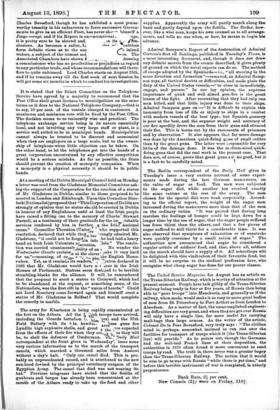Admiral Sampson's Report of the destruction of Admiral Cervera's fleet
off Santiago, published in Tuesday's Times, is a most interesting document, and, though it does not draw any definite morals from the events described, it gives plenty of ground on which the naval experts can do so. The method of escape adopted by the Spaniards—i.e., "all steering in the same direction and formation "—removed, as Admiral Samp- son says, all tactical doubts or difficulties, and made plain the duty of the United States vessels,—" to close in immediately, engage, and pursue." In our lay opinion, the supreme importance of quick and well aimed gun-fire is the great lesson of the fight. After recounting that they had only one man killed, and that little injury was done to their ships, Admiral Sampson goes on :—" It is difficult to explain this immunity from lose of life or injury to ships in a combat with modern vessels of the best type ; but Spanish gunnery is poor at the best, and the superior weight and accuracy of our fire speedily drove the men from their guns and silenced their fire. This is borne out by the statements of prisoners and by observation." It also appears that far more damage was done by the American quick-firing g‘,ns of small calibre than by the great guns. The latter were responsible for very little of the damage done. It was the m.'dinm-sized quick- firing guns that did the real work in the present case. That does not, of course, prove that great guns a no good, but it is a fact to be carefully noted.


































 Previous page
Previous page